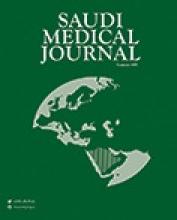Abstract
OBJECTIVE: To highlight the importance of MRI in evaluation of the tempromandibular joint (TMJ).
METHODS: The MRI examination was performed at King Khalid University Hospital, Riyadh, Saudi Arabia with the approval from the local ethics committee, on 34 patients (68 joints) between January 2006 and November 2007, in which 10 were considered asymptomatic subjects (control). The remaining had symptoms and signs of TMJ pain or dysfunction, including limitation of movement and clicking. All our subjects were examined in both closed and open mouth position. Images were obtained by 1.5-T MRI system, in oblique sagittal plane utilizing 3 pulse sequences including T1 and T2 spin-echo, and spoiled gradient recall sequences. The evaluation of the meniscal disc configuration and position was carried out by 2 radiologists.
RESULTS: Sixteen out of 20 joints of asymptomatic subjects were normal. In the other 2 asymptomatic subjects, the MRI showed anterior disc displacement with reduction in 3 joints, and degenerative changes in 2 joints. Out of the 48 symptomatic joints, 26 (45%) joints were considered normal, while the other 22 joints showed anterior dislocation without reduction. Degenerative joint disease was also seen in 18 joints.
CONCLUSION: The MRI with the use of surface coils markedly improves the delineation of internal derangement of the TMJ, therefore, it enhanced the capability of detecting certain abnormalities, which proved to have a statistical significance in symptomatic patients.
- Copyright: © Saudi Medical Journal
This is an open-access article distributed under the terms of the Creative Commons Attribution-Noncommercial-Share Alike 3.0 Unported, which permits unrestricted use, distribution, and reproduction in any medium, provided the original work is properly cited.






